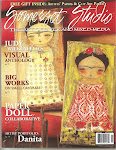I got quite a few questions on my last post and some from "no-reply" bloggers so I thought I would try to answer some of them here. First of all, I am NOT a button expert, I am not even a button collector and I have never been to a real button show. I am just a button accumulator with a curious mind.
Some asked what "whistles" are. They are buttons, as shown above, that have one hole on the front and two holes on the back. Yes, I have tried blowing through them, because I am like that, and no, they didn't whistle. I have no musical talent so that may be the problem.
This is the back side where you can see the two holes.
Someone asked about vegetable ivory. I have no idea why it is called that because they are actually buttons made from the tagua nut. I believe the three brown buttons above are made from vegetable ivory. They are often stained or dyed. The dye doesn't penetrate very deep so they can then be carved and the lighter color underneath is revealed. It is especially common to find them with a groove carved on each side of the shank so you can insert a needle and the groove is often lighter in color than the rest of the button.
I mentioned in the last post that I should have taken a photo of the milkglass whistle from an angle where you could see the ball shape so here you go.
More questions and answers...
Yes, bone buttons are really made from bone. They were made from the shin bones of cattle. I find it admirable that our ancestors made use of every part! There are even buttons made from the horns. The holes in very early ones sometimes don't match because they lacked the technology to do that. I have also heard there are ones with three holes but I have never found one.
Mother of Pearl buttons have nothing to do with oysters or pearls. IOWA was once the button capital of the world and the buttons were made from mussel and clam shells harvested from the Mississippi River. You have probably noticed that some of the modern clothing you buy still has MOP buttons. They are made in Asia now.
Tight Top buttons are typically made of celluloid that is firmly attached to a metal back. By the way, I always talk about washing buttons but you should NEVER wash a two-piece button that has metal parts. The water will get inside and ruin it. I just use a damp dishrag to clean them.
Someone asked about my button books. These are what I have, but I have room for more!! The Internet also offers tons of information.
Button Button by Peggy Ann Osborne.
Buttons by Diana Epstein and Millicent Safro
Antique & Collectible Buttons by Debra Wisniewski
Old Buttons by Sylvia Llewelyn
I hope this helped answered some of your questions. Happy button hunting!
The Evolution Of Holidays... And... America
1 hour ago














9 comments:
Never knew about those whistles - or Iowa being the button capital, either! My favorite thing is to find buttons on the card, and the card says exactly what they are, because I need all the help I can get!
I need to go through my buttons now and see what I have. I'm disappointed to know the newer MOP buttons are made in Asia. Thanks for the great info!
Thank you for the lesson in buttons Kathy! I never knew any of this, so you've helped me out immensely. I love old buttons too!
I have jars and jars and jars of buttons sorted by color but know nothing about them..shame on me
It's good to know that I'm not the only person who had to test out a whistle button:-)
Thank you for all this info! I am such a dumborina, I thought a MOP was another kind of button, never realizing it was mother of pearl.
Thanks for sharing such great info on buttons!! I am impressed!! xo Heather
A very interesting post Kathy - thanks! And I think you are a bit more than just an accumulator!
Thanks, Kathy, for the button lesson. I never knew any of this and it's sad because I have one of the same button books that you have. I just never bothered to research.
Post a Comment